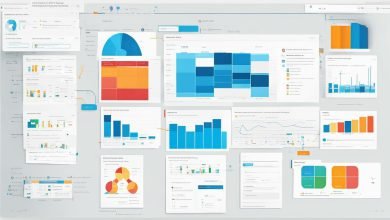
Welcome to your comprehensive guide on Azure monitoring with Azure Monitor. In today’s fast-paced business world, cloud computing has become an essential solution for enterprises of all sizes. However, managing cloud operations can be a daunting task, especially when it comes to monitoring and optimizing system performance.
This is where Azure Monitor comes in. As a cloud-based monitoring solution, Azure Monitor provides real-time insights into the health and performance of your cloud resources. With Azure Monitor, you can monitor metrics, analyze logs, and receive alerts to proactively troubleshoot and optimize the performance of your Azure resources. In this article, we will explore the various features and services offered by Azure Monitor and best practices for using this solution to maximize your cloud performance.
Key Takeaways:
- Azure Monitor is a cloud-based monitoring solution that provides real-time insights into the health and performance of your Azure resources.
- Azure Monitor offers various features and services such as metrics, logs, alerts, and dashboards.
- By using Azure Monitor, you can proactively troubleshoot and optimize the performance of your Azure resources, ensuring efficient system operations.
Azure Monitor Services: Maximizing Cloud Performance
Azure Monitor provides a wide range of services that help in monitoring and fine-tuning your cloud environment, ensuring optimal performance. These services include:
| Azure Monitor Alerts | Azure Monitor Logs |
|---|---|
| Azure Monitor Alerts allow you to configure alerts on your cloud resources based on specific performance conditions. You can create alerts for metrics such as CPU usage, memory usage, and network traffic, providing real-time notification when a threshold is breached. These alerts enable proactive action and help to optimize your cloud performance. | Azure Monitor Logs provide a powerful tool for troubleshooting and diagnosing issues in your cloud environment. With Azure Monitor Logs, you can collect and analyze log data from various sources, including Azure resources, applications, and system logs. You can also perform queries on the log data, visualize it using charts and tables, and set up alerts based on log data. |
Another critical monitoring service in Azure Monitor is Azure Monitor Metrics. It enables you to collect and analyze performance data from Azure resources. You can use these metrics to monitor the health and performance of your resources and detect issues before they impact your system’s efficiency.
Furthermore, Azure Monitor offers Azure Monitor Dashboards, which you can leverage to create customized dashboards to monitor and analyze the performance of your cloud resources. The dashboards can be used to track specific metrics and provide quick insights into the status of your resources.
Azure Monitor Services: Maximizing Cloud Performance
These Azure Monitor services are essential for proactive cloud monitoring and troubleshooting. By using these services, you can optimize your cloud performance, and ensure efficient system operations.
Azure Monitor: Best Practices and Documentation
To ensure effective monitoring and optimal performance, it is essential to follow best practices when configuring Azure Monitor. The following tips can help you get the most out of Azure Monitor:
- Define clear objectives: Before configuring Azure Monitor, it’s essential to determine your monitoring objectives. Define what you want to monitor, including which metrics, logs, and events to track, and establish thresholds to trigger alerts. Clear and specific objectives enable more effective monitoring and more accurate identification of potential issues.
- Configure alerts thoughtfully: Configuring alerts is an important part of monitoring your cloud environment, and it’s essential to do it thoughtfully. Define criteria that trigger alerts carefully and avoid generating excessive alerts that might create alert overload. You can leverage Azure Monitor’s features to filter and group alerts efficiently.
- Review logs regularly: Logs are a powerful tool for diagnosing and troubleshooting issues in your cloud environment. Review logs regularly to identify patterns and trends in your system’s behavior. Azure Monitor offers powerful log querying capabilities, making it easy to access and analyze your log data.
- Tune your configurations: Azure Monitor is a flexible and configurable service that provides granular control over the elements you monitor. Fine-tune your monitoring configurations regularly to ensure they align with your objectives and are optimized for your system’s performance.
Beside adopting these best practices, leveraging Azure Monitor’s documentation resources is crucial for effective monitoring. Azure Monitor provides comprehensive documentation, including detailed guidance on monitoring Azure resources, querying and analyzing data, and using Azure Monitor features. Make sure to keep up-to-date with the available documentation resources and use them to improve your monitoring and optimize your system’s performance.
Azure Monitor Metrics and Logs
Azure Monitor metrics are essential for gauging the performance of your system and ensuring its health. It collects data on various parameters such as CPU usage, network activity, and other performance indicators, providing valuable insights into the functionality of your Cloud resources.
Azure Monitor logs, on the other hand, provide a detailed record of events that occur within your system, helping you identify potential issues and inconsistencies, so you can take proactive measures to prevent them. By using Azure Monitor logs, you can track the performance trends of your system, monitor user activities, and measure resource utilization, among other things.
Combining Azure Monitor metrics and logs can provide you with a comprehensive overview of your system, enabling you to easily identify issues and take corrective actions. By leveraging the insights derived from Azure Monitor metrics and logs, you can optimize your system’s performance, ensuring it runs smoothly and efficiently.
Conclusion
Azure Monitor is an essential tool for effective cloud monitoring. By utilizing the various services and features of Azure Monitor, businesses can maximize their cloud performance and optimize their system operations. From real-time issue monitoring to proactive action, Azure Monitor simplifies cloud management like never before.
As discussed in this article, adopting best practices for monitoring configuration, setting up alerts, regularly reviewing configurations, and leveraging the available documentation resources can significantly enhance the effectiveness of Azure Monitor. By collecting and analyzing metric data, Azure Monitor provides valuable insights into the health and performance of cloud resources while the use of Azure Monitor logs helps in diagnosing and troubleshooting issues.
Emphasize the importance of Azure Monitor
Therefore, we encourage all our readers to adopt Azure Monitor as their go-to tool for cloud monitoring. Azure Monitor provides an efficient, reliable, and cost-effective solution to monitor the health and performance of cloud resources. By leveraging the benefits of Azure Monitor, businesses can stay ahead of potential issues and optimize their cloud performance.
FAQ
Q: What is Azure Monitor and why is it important for cloud monitoring?
A: Azure Monitor is a comprehensive monitoring solution offered by Microsoft for monitoring and managing cloud resources. It provides real-time insights into the health, performance, and availability of your applications and infrastructure in Azure. Azure Monitor is important for cloud monitoring as it helps optimize cloud performance, ensure efficient system operations, and proactively identify and resolve issues.
Q: What are the key features and services offered by Azure Monitor?
A: Azure Monitor offers a range of features and services that enhance cloud monitoring. These include Azure Monitor alerts, which notify you when specific conditions are met; Azure Monitor logs, which enable centralized log management and analysis; Azure Monitor metrics, which provide performance data and insights; and Azure Monitor dashboards, which allow for visualizing key metrics and trends in your environment.
Q: How can Azure Monitor help in maximizing cloud performance?
A: Azure Monitor provides various services that help maximize cloud performance. With Azure Monitor alerts, you can proactively detect and respond to issues, ensuring optimal performance. Azure Monitor logs allow for troubleshooting and diagnosing issues in real-time, leading to enhanced cloud performance. Utilizing Azure Monitor metrics provides visibility into the health and performance of your resources, enabling you to optimize performance efficiently.
Q: What are the best practices for optimizing Azure Monitor?
A: Optimizing Azure Monitor involves setting up effective monitoring, configuring alerts based on relevant metrics, and leveraging the available documentation resources. It is important to review and fine-tune monitoring configurations regularly to ensure optimal performance. Following best practices, such as defining alert thresholds, configuring diagnostic settings, and utilizing monitoring templates, can help optimize Azure Monitor usage.
Q: How can Azure Monitor metrics and logs be leveraged for cloud troubleshooting?
A: Azure Monitor metrics provide valuable performance data that can be analyzed to troubleshoot issues in your cloud environment. By monitoring metrics like CPU usage, memory usage, and network throughput, you can identify performance bottlenecks and optimize resource utilization. Azure Monitor logs, on the other hand, allow you to centralize and analyze log data from various sources, aiding in troubleshooting and diagnosing issues across your cloud infrastructure.







